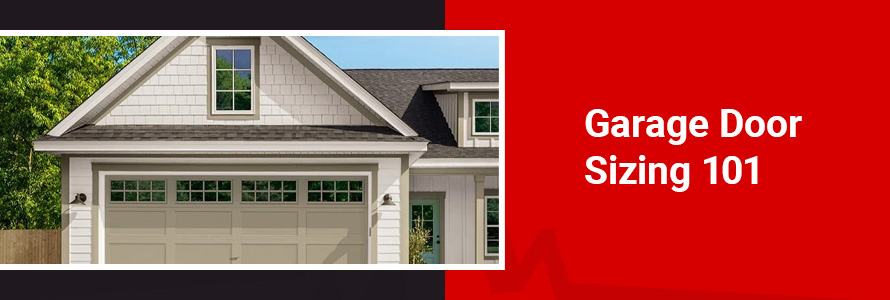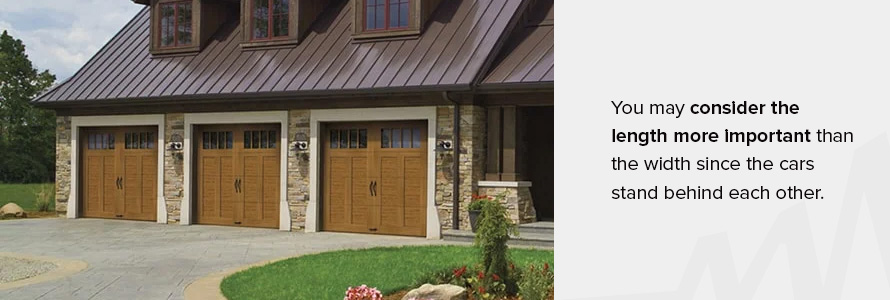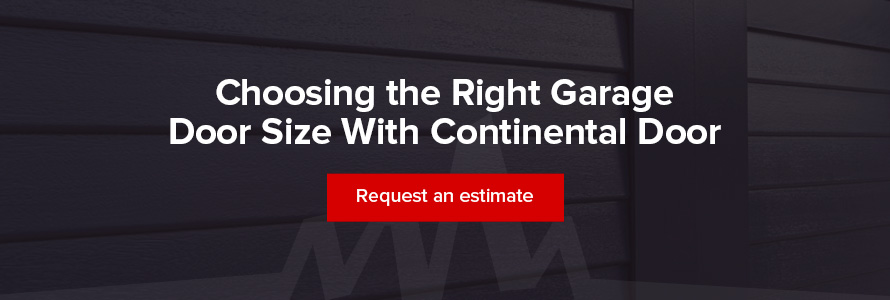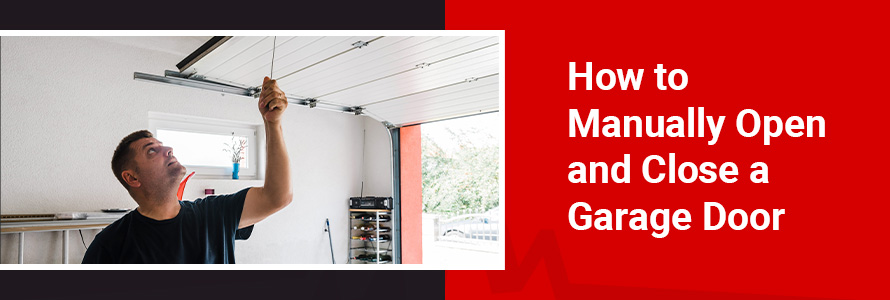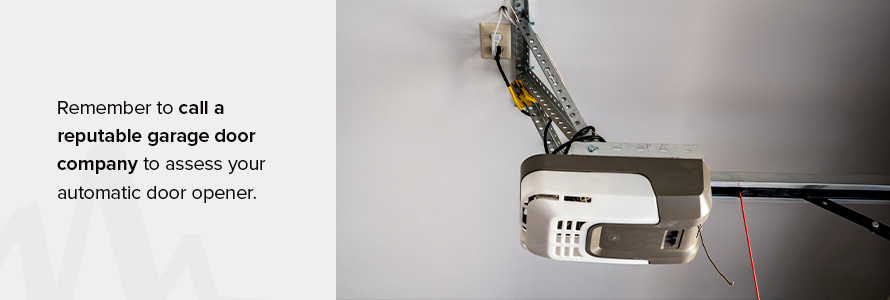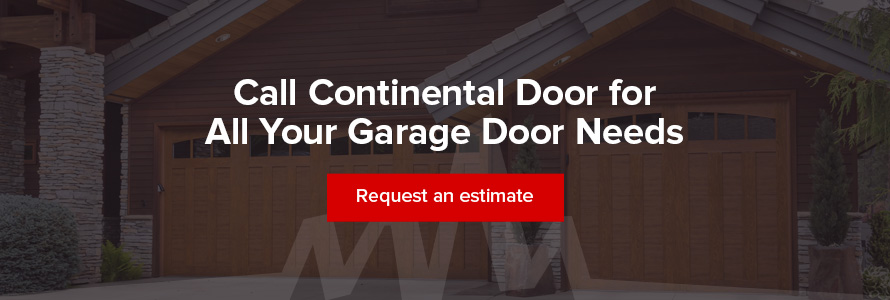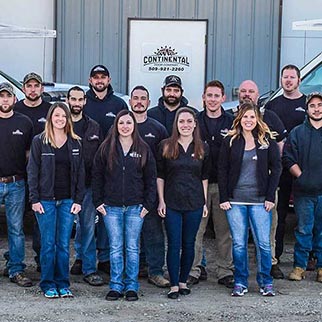The Benefits of a 1.5-Car Garage
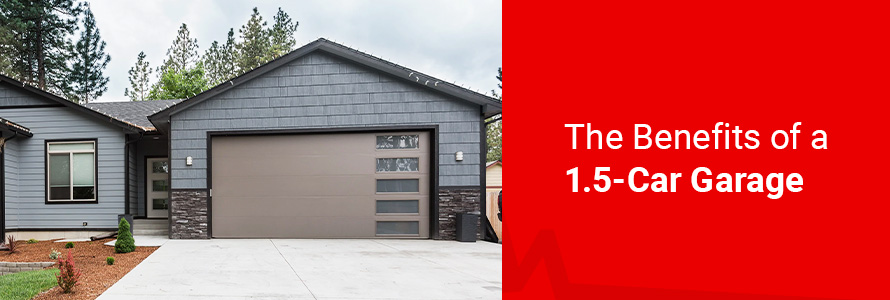
Admittedly, the name is a little bit silly. No one owns half of a car — or at least not one that is drivable! Why, then, is there a designated 1.5-car garage size? Surprisingly, the importance of the 1.5-car garage is growing, especially for homeowners with limited space on their property. Even those who already own a garage are opting to renovate it.
Contact UsIf you find that your garage currently feels cramped or are looking into ways a garage can add to the value of a home, consider whether the 1.5-car garage is the solution for you.
You’ll want to investigate aspects such as 1.5-car garage dimensions, the pros and cons, how exactly to increase your garage size and what goes into installing a new garage door to fit it. This guide provides tips, tricks and information to help you make your decision. Join us as we discuss all things 1.5-car garage!
Table of Contents
- How Big Should My Garage Be?
- What Is The Average Size of a 1.5-Car Garage?
- What are the Benefits of a 1.5-Car Garage?
- How do I Install an Oversized 1.5-Car Garage Door?
- Should I Expand My Garage?
- Are There Any Other Tips for Renovating a 1.5-Car Garage?
- Where Can I Buy One-and-a-Half-Car Garage Doors?
How Big Should My Garage Be?
When looking at statistical trends in new home builds, it is clear that the two-car garage is king. According to a recent study from the National Association of Home Builders (NAHB), 66% of all the new houses that broke ground in 2022 included a two-car garage. An additional 19% featured a garage with enough space for three or more vehicles.
However, not everyone who adds or expands a garage has an open lot available. In such cases, a two- or three-car garage might not be feasible, but a 1.5-car garage may be the perfect solution.

What Is The Average Size of a 1.5-Car Garage?
As the name implies, a 1.5-car garage is slightly bigger than a one-car garage but not quite as big as a two-car option. A standard 1-car or single garage measures between 12 and 16 feet in width, while a standard two-car or double garage usually measures between 20 and 24 feet wide. A standard three-car or triple garage is 30 feet wide.

The dimensions of a standard size 1.5-car garage fall between the single and double garages at 16 to 20 feet wide. Some 1.5-car garages use one-car garage doors, while others capitalize on the extra space and install a larger 1.5-car garage door. Those with larger vehicles often opt for the latter.
All standard garages have roughly the same depth, about 22 feet to 24 feet — although some home designers have chosen special, extra-deep garages. The extra depth is especially useful for boat owners or those who have oversized trucks that could benefit from the additional length. If you are mostly interested in the 1.5-car garage because of the size of the vehicle you are looking to park in your garage, then added depth might be as useful as added width.
In other words, if you are wondering what the best sizes for a garage are, the answer will vary greatly depending on your needs.
What Are the Benefits of a 1.5-Car Garage?
If you have a fleet of vehicles you want to park under a roof every night, the 1.5-car garage may not be for you. However, for those with limited options for expansion, the 1.5-car solution is a perfect fit.
Let’s break down the many benefits of the 1.5-car garage:
1. Small Footprint on Tight Lots
If you live in an urban area, the 1.5-car garage may be the best way to avoid risky street parking. Additionally, if you own an urban or historic home, you know that expansions can be a headache. Houses were not constructed on large yards or acres of property. In such situations, garages may need to be fit into smaller spaces.
However, the standard one-car garage can be limiting. If you want to use a garage for parking a car as well as additional storage, the standard one-car garage just isn’t big enough. On the other hand, the two-car garage may be too big. Especially in historic districts, adding a garage with street access may be difficult, and adding access to two doors may be impossible.

In such situations — where a homeowner wants both versatility and a smaller footprint, the 1.5-car garage is the ultimate compromise.
2. Accommodates Large Vehicles and New Drivers
If you have a new driver under your roof, you know that even the most responsible teenager is liable to scratch a rearview mirror or two. Becoming confident in the width of your rearview mirrors takes years of practice.
However, the risk to the rearview mirrors — as well as the side panels — of your car rises exponentially if your vehicle is wider. If your teen driver is learning on the family minivan, a tight single garage might be even more of a challenge than if you had a sedan.
Many with larger vehicles, such as vans, large SUVs and pickup trucks, opt for a 1.5-car garage with an equally oversized door. While some 1.5-car garages still feature the standard single-size door, the oversized door is a perfect pairing for an equally oversized car.
While this is especially helpful if you have a driver in the household who’s still using their learner’s permit, even if you have years of experience behind the wheel, you could still benefit from some additional side clearance when parking a big vehicle. In fact, if you have a commercial-grade vehicle, the oversized door might be a necessity. Parking in a single-car bay may amount to more than just threading a needle — it may be an impossibility.
3. Provides More Space for Loading and Unloading
For those with very young kids — especially those who still ride in a car seat — the extra clearance on each side of the car will make loading kids in much easier. Leaning into the backseat of a vehicle to latch a kid into their seat is hard enough. Doing so with limited space between the car and a wall makes the process downright back-breaking!
Even if you don’t have little kids, if you regularly transport things — such as groceries, equipment or luggage for travel — in the back seat of your car, having additional space for loading and unloading can make the process much less painful!
4. Gives You Added Storage
While a garage, by its most basic definition, is a place to store vehicles, many of us use that space to store countless other things. In fact, too much non-car storage has become a problem for many homeowners.
According to a 2022 survey, 36% of Americans said their garages are so cluttered that they can no longer fit vehicles inside them.
Unfortunately, the chances of joining this group exponentially increase if you have a single-car garage. That’s because the space is not designed for additional storage in the first place.
However, even if you have a small property and only one car, there are still plenty of things you’d probably love to keep in your garage — garden equipment, snow-clearing tools and sports gear perfectly suit garage storage.
That’s where the 1.5-car garage comes in. The added clearance on both sides of the car and space in the back of the garage can be utilized as storage space. Add in some well-designed storage solutions, and you can ensure you have plenty of space to park both your car and your lawnmower without damaging either.
5. Increases Available Work Space

Whether you are an artist, carpenter, craftsperson, aspiring rock star or a do-it-yourself mechanic, the garage is a great place for your craft. A 1.5-car garage’s expanded size makes the space even more versatile.
If you like to work on your car yourself, you have likely collected several mechanic’s tools over time. These tools take up space. However, considering that they are designed to be used on your car, it doesn’t make much sense to store them in your basement. They are often heavy and can become covered in grease, making transportation laborious and potentially messy. You also don’t want to leave them somewhere insecure, as they can also be expensive. With a single-car garage, both storing your equipment and parking your car is a challenge. A 1.5-car garage gives you the space you need.
If you use your garage as a practice area for an aptly named garage band, you need to make sure you have the space to rock out. While you will likely move your car into the driveway while you practice, a 1.5-car garage allows you to store your equipment between practices.
Regardless of how you use the space, a 1.5-car garage makes that space more versatile.
6. Enhances Accessibility
Guests and household members who use mobility aids benefit greatly from the extra space alongside parked vehicles. Walking frames, wheelchairs and rollators can be more easily maneuvered around the vehicle with a wider perimeter. You may even want to install railings on your garage walls now that you have room.
How Do I Install an Oversized 1.5-Car Garage Door?
While it is easy to see the many benefits of a 1.5-car garage door, the fear of installing one can often deter homeowners from investing. To demystify the process, here’s a short explanation of what is involved in the installation process.

Doors for 1.5-car garages are not a common size. That means many homeowners who want a 1.5-car garage door cannot simply order a standard door and be done with it. For those who are interested in a 1.5-car garage for the added storage but do not necessarily need a larger door, then this isn’t a big deal. In such cases, a standard single-car door may suffice.
However, if your primary motivation for investing in a 1.5-car garage is to accommodate a larger vehicle, an oversized garage with a regularly sized door won’t improve your situation.
In these cases, a custom door is the best solution. That way, you can invest in a garage door that perfectly matches your specifications. Because custom doors are designed to certain specifications, they cannot be mass-produced.
The key to maximizing value without breaking the bank lies in finding a custom garage door manufacturer that is affordable without sacrificing quality. In such cases, you need to partner with a custom fabrication company with a sterling reputation, such as Spokane and Coeur d’Alene’s own Continental Door Company.
A good fabricator will have the tools necessary to make doors to any specification. This includes being well-stocked with common raw spring snakes, meaning they can cut springs — a crucial piece of any garage door — to any length. They will also need the means to customize track assemblies. Finally, welding shops will need to have the means to shape, customize and support heavy steel doors, providing homeowners with beautiful doors that will stand the test of time.
Adding Value to Your Home
As with any home improvement, a garage renovation is about more than added convenience — although that is a huge factor! A garage expansion also has the potential to add incredible value to your home. For those who want to resell their home at some point in the future, added value has the potential of recouping a large portion of the initial investment.
According to Home Advisor powered by Angi, a garage addition will recoup 75% to 85% of its total cost upon selling your house. Regarding return on investment (ROI), that means a new garage ranks above the National Association of Realtors (NAR) ROI 2022 estimation of a complete bathroom renovation (71%) and the addition of a master suite (56%).
As far as increased home values are concerned, a new garage is a safe bet. Other factors — such as the availability of garages in other homes in the neighborhood — could further increase a new garage’s ROI.
However, if you already have a garage and want to improve it — such as expanding the size of the door — then your ROI will actually increase. According to NAR’s 2022 home remodeling research, a new garage door can recoup 100% of its initial cost upon resale. The study also showed that 80% of renovators felt a greater desire to be home after getting their garage door replaced.
Even more promising is JLC’s 2024 Cost vs. Value Report, which placed garage doors as the number one remodeling project for return on investment, reporting a staggering national average of 193.9% cost recuperation. In Spokane, Washington, specifically, the ROI on new garage doors is significantly higher, at 227.5%, meaning you get the entire cost of your new garage door back upon resale, plus over 100% profit.
In addition to ROI, a new garage might make your home more appealing when it goes up for sale. For instance, if you are selling during a time that could be described as a “buyer’s market,” getting a leg up on the competition is a great way to sell a home and avoid costly time spent on the market.
Improving Your Daily Life
Regardless of the dollars and cents of the project, you need to think about how a garage door replacement, addition or expansion will improve your daily life. If you have a hobby that brings you joy but don’t have the space to do it, then the way an expanded garage improves your life will be worth the cost.
If you have a driver in your family who consistently sends you to the paint department at your car dealer, then consider the amount of money a wider door might save you. And if you’re constantly having to bend in awkward positions to get your child into their car seat, then the investment just might be worth it, too.
Are There Any Other Tips for Renovating a 1.5-Car Garage?
If you really want to maximize the ROI of a new 1.5-car garage, there are little things you can do that will go a long way. Here are some of our best tips for maximizing your renovation:
1. Invest in Insulation
If you are renovating an older garage, it likely needs to be better insulated. As homeowners nationwide have become more aware of energy costs and carbon footprints, many new builds have focused on adding insulation. However, even those who add insulation to their older homes often overlook their garages.

Luckily, adding insulation is easy when you are doing a renovation. You will already have your garage empty and installation equipment ready. Basic insulation also isn’t too pricey, so it can likely fit into your budget.
2. Improve Security
Just as older garages tend to lack insulation, they also regularly need enhanced security.
New doors often come with extensive security features and innovative smartphone connectivity options, both of which appeal to most homebuyers. These technological upgrades will also keep your home safer, meaning they are a great investment for you and your family, even if you are not planning on selling anytime in the near future.
3. Look out for Tax Credits
Although our tax system is currently evolving, you should always keep an eye out for home improvement-related tax credits. These are especially prevalent for those looking to improve energy efficiency.
If you can take advantage of tax credits, you can further improve your ROI by recouping investment costs even before it comes time to sell.
Keep in mind that some of these tax credits are specific to your state or locality. So, even if a federal tax credit isn’t available, you may be able to find a state or local credit that can help defray the cost of investing in energy-efficient improvements.

4. Think About Curb Appeal
While we all have our personal tastes, if you are looking to maximize ROI, you need to make sure your improvements are in line with current trends. That way, your home will be more appealing to future buyers.
Luckily, even a new garage door can drastically increase your home’s curb appeal. This relatively inexpensive renovation means you can quickly and drastically increase your chances of selling your home by simply switching out an old, dated door with a new one.
5. Consider Maintenance Costs
When calculating the cost/benefit of a garage renovation, also consider the cost of maintaining an aging door and opener. With so many moving parts that are used repeatedly, day after day, an older door can become more costly to repair than to replace.
So, if your door frequently requires you to reach for the phone and call for a repair, investing in a new door may be a wiser economic move.
These are only a handful of the many things to consider when looking into a garage renovation.

Where Can I Buy One-and-a-Half-Car Garage Doors?
If you are ready to invest in a new garage door, it is imperative that you turn to a partner you can trust. If you are in Spokane, Spokane Valley, Coeur d’Alene or the surrounding area, you can rely on Continental Door Co. for your 1.5-car garage door purchases and services. We’re proud to offer free design consultations for new construction projects and employ an experienced team of well-trained technicians.
Contact UsRely on Continental Door, Co. to Perfect Your New Garage
Since 2000, we have been serving the greater Spokane, Washington, area, providing peerless residential garage door installation, service, maintenance and repair, as well as custom garage door fabrication. We focus on passing on value to our customers, ensuring affordability and prioritizing premium quality.
If it’s time to install your 1.5-car garage door or build your 1.5-car garage addition, contact us online today!

Request Information About Garage Doors
Updated: 09/19/2024
Garage Door Sizing 101
Common Garage Door Sizing
Getting the right garage door size is essential when installing a new garage door at home. The number of cars your garage holds determines the size, but the measurements must be accurate to ensure a door that fits.
Explore the standard garage door sizes for various sized garages, including smaller and custom garage doors.
Understanding Garage Door Sizes for Your Home or Project
Whether you’re building a new garage or expanding your current one, the garage space comprises different dimensions that must be calculated individually and holistically to get the right door measurements. A tape measure is sufficient to calculate all the dimensions within the garage. These are the main areas to consider:
- Garage door opening: The opening or entrance to the garage is the size of the garage door, allowing the car to pass through. The door opening height and width are measured in inches.
- Side room: This is the space between the walls and garage door openings on both sides. Torsion springs are usually fitted in this space and should ideally be 3.75 inches on each side.
- Headroom: This is the area between the ceiling and the top of the door opening. Include the garage door opener clearance, usually about 3 inches.
- Backroom: This is the depth of the garage or the length between the opening and the back wall.
- Floor: This is the ground space between the four garage walls measured in length and width or square footage.
Overview of Standard Garage Door Sizes
Garage door sizes vary according to home sizes, but most are standard unless there are custom requirements.
The car sizes impact the dimensions as some homeowners may build according to the vehicle types. For example, they may have a hatchback, a Jeep or SUV, and an RV they want to park in one garage. Standard double garage door dimensions may not be suitable in this case.
The common dimensions for one- to four-car garages are measured in width by depth in feet, while other uncommon dimensions are included in the following section.
- One-car garages: These hold one car and are typically available in 8-by-7 feet, 8-by-8 feet, 9-by-7 feet or 9-by-8 feet. Another popular dimension is 12 -by-20 feet to accommodate a bigger vehicle and have enough space to walk around it in the garage and open the doors without touching the walls.
- Two-car garages: These fit two cars and come in standard sizes of 16 feet by 7 or 8 feet.
- Three-car garages: To fit three cars in a garage, you need approximately 30-by-20 feet up to 36-by-feet of space.
- Four-car garages: Housing up to four cars, this garage size is at least 40-by-20 feet up to 45-by-24 feet.
Detailed Dimensions for Various Garage Types
Regarding garage sizes, there are standard measurements, but the reality is that everyone’s needs differ. It’s not always a one-size-fits-all scenario. We explore the detailed dimensions for different garage types and what might best suit your requirements.
One-Car Garage Dimensions and Square Footage: Essential for Small Households
The dimensions for one-car garages are usually based on the home size. Households with only one vehicle don’t need much space but still need to avoid making the garage too small. Some smaller homes might have limited storage space, and a larger garage can help solve this problem.
In general, one-car garage dimensions include:
- Width: 12-18 feet
- Depth: 20-30 feet
- Additional sizes: 12-by-25 feet, 12-by-30 feet, 18-by-25 feet and 18-by-30 feet.
- Garage door width: 9-12 feet
- Area in square feet: 240-540 square feet
For more storage space, you could add half a car’s size in width, making the garage 18 feet wide instead of 12 feet. A 1.5-car garage provides ample space for a minivan or SUV in a single garage.
Two-Car Garage Dimensions and Square Footage: Ideal for Growing Families
Having multiple cars is common for growing families, so it’s important to accommodate an appropriate-sized garage. On average, double garages fit two cars and are measured as follows:
- Width: 22-30 feet
- Depth: 24-30 feet
- Additional sizes: 20-by-30 feet, 24-by-25 feet and 24-by-30 feet
- Garage door width: One 16-foot or 18-foot wide door, or two 9- to 12-foot wide doors
- Area in square feet: 360-660 square feet
The deeper or longer the garage, the more space you’ll enjoy. Consider adding 3-5 inches, depending on your vehicles’ sizes. You may want to have enough space for 2.5 cars, so you have extra room for storage or a workbench.
Three-Car Garage Dimensions and Square Footage: Balancing Space and Functionality
When you’re parking three cars, there are ways to balance space and functionality. Here, you may consider the length more important than the width since the cars stand behind each other. If parked next to each other to save space in length, one single garage and a double garage make sense.
Or, you could incorporate a four-car garage and use the additional space for storing smaller vehicles like a motorcycle or convert it into a workshop area.
How many square feet is a three-car garage? Standard dimensions for a single and double garage layout are typically these below:
- Width: 32-22 feet
- Depth: 20-30 feet
- Additional sizes: 36-by-24 feet
- Garage door width: An 8- to 10-foot-wide door and a 16- or 18-foot-wide door
- Area in square feet: 600-1,260 square feet
Detached three-car garages are another option if you don’t have space for an attached garage. Common dimensions for these include 32 x 24, 34 x 24 and 36 x 28.
Four-Car Garage Dimensions and Square Footage: A Multifunctional Space
Four-car garages require the most space in length and width and are versatile. So, how big is a four-car garage? These are the standard measurements:
- Width: 40-48 feet
- Depth: 20 feet or more
- Additional sizes: 24-by-45 feet
- Garage door width: Four 9- to 12-foot wide doors or two 16- to 18-foot wide doors
- Area in square feet: 800-1,680 square feet
Homeowners with four-car garages commonly use the extra space as a workshop, gym or recreational area.
Exploring Uncommon Garage Door Sizes
While most garages use standard garage door sizes, sometimes garages are built according to specific dimensions. Half sizes like 1.5 or 2.5-car garages can allow for more storage or workshop space, and five-car garages hold all your vehicles and projects.
With these, you’d add half a car’s width or more to standard sizes to achieve the ideal size.
Maximizing Your Garage’s Potential
The factors below contribute to maximizing your garage’s potential as you consider space and customization options.
Factors Influencing Garage Door Size Selection
Some factors that may influence the garage door size include:
- Garage type: The two main garage types are attached and detached from your home.
- Storage requirements: If you store hobby items and other goods alongside the parked cars, you’ll need a larger garage, which could mean a bigger door.
- Vehicle size: Ensure your garage is deep and wide enough to accommodate your varying vehicle sizes.
- Number of vehicles: Account for all your vehicles, including smaller, light vehicles like bicycles, motorbikes and scooters.
- Additional functionality: You may want to convert a section of a larger garage into a recreational or work area if you use a larger garage to park only one or two cars.
Utilizing Space Efficiently in Larger Garages
Larger garages allow numerous opportunities for utilizing space effectively. Whether you have a one-car or a four-car garage, you can use it for storage or as a recreational or work space.
Consider the garage layout and which parts are free. Corners and the far end are usually available to put up storage units or stack boxes. If there’s enough space, a table and chairs can create a lounge area.
Custom Garage Door Sizes: Tailoring to Your Needs
When planning a custom garage door, explore the options until you’re satisfied with what you can get. Value for money without compromising quality is key when considering the best local garage door companies.
A reputable contractor will advise you on customization preferences, like what can and can’t be customized. Explore their selections and what they can do for you.
Choosing the Right Garage Door Size With Continental Door
Continental Door’s expert team is always available to help our valued customers in Spokane and the surrounding areas. We have been driving customer satisfaction since 2000 and strive to deliver the best service.
If you’re interested in installing a new garage or upgrading your current one and need help determining the right garage door sizes, call us or request a free estimate today. We are always eager to help!
How to Manually Open and Close a Garage Door
How to Manually Close and Open Your Garage Door
In the past, manually opening and closing a garage door was common practice. Drivers had to get out, unlock the garage door, lift it, drive in, park and close the door behind them. These days, most garage doors are automatically operated, so the driver can easily open and close the door by remote control.
We may not need it often, but knowing how to manually open and close a garage door is important when necessary. Here’s how to open your garage door manually when there’s a reason it won’t open automatically.
Can You Manually Open and Close a Garage Door?
What happens if the power goes out? How do you open a garage door without power? What if you lose the remote? What if your garage door opener is broken? Do you know how to open a garage door without the remote? There are several reasons you should know how to open an electric garage door manually. If you can’t open the garage door manually when needed, read on to learn more.
Safety Precautions Before Manual Operation
Safety should always be your priority when handling a heavy garage door. Numerous moving components can pose a risk, including:
- Faulty or broken springs
- A door knocked out of its tracks
- Loose or snapped cables
Inspecting these parts regularly for wear and tear can help you identify and prevent issues later.
Forcing the door closed when the springs are broken can cause it to slam down forcefully. This can damage the door or harm anyone standing close. This is why it’s important to know why the door isn’t working automatically before attempting to operate it manually.
A professional garage door technician will identify the problem beforehand to ensure no issues could lead to damage or harm.
Preparing Your Garage Door for Manual Operation
Before handling your garage door manually, check that the springs, tracks, rails and cables are in working condition. The door should balance evenly and lift without too much resistance. Be careful when handling the door, as it can be surprisingly heavy, especially wooden doors. Aluminum and steel doors are lighter to handle.
Double-check to see whether the source of the problem is a power outage, and inspect the garage door remote control for dead batteries.
How to Open a Garage Door Manually
Opening the garage door manually is not too difficult. When you find yourself in a situation where technology fails you, manual operation is your only option. A power outage is usually the cause of your opener failing, but the opener could also be faulty. How to open an electric garage door manually depends on whether you’re trying to get in or out.
Opening the Door From the Inside
When you’re stuck inside and need to be somewhere, the last thing you want to deal with is an unresponsive garage door. Follow these steps to open it manually from the inside:
- Disengage manual locks or deadbolts.
- Turn off the garage door opener power source if it’s not already off.
- Find and pull the red hanging emergency release cord from the center track, disengaging the door from the garage opener.
- Lift the door by pulling it upwards from the center over your head, where it will slide onto the track and remain firmly in place.
- Pull out your car and lower the door manually again.
- Engage manual locks or deadbolts to secure the door.
Opening the Door From the Outside
If you’ve come home and can’t access your garage, you can also open the door manually to get inside. Here’s what to do:
- Find the emergency built-in release with a key slot at the top of your garage door.
- Enter and turn the key, then pull the lock mechanism outward.
- The emergency release cord should be disengaged.
- Pull the cord, disconnecting the motor.
- Unlock the garage door at the bottom next to the door handle.
- Lift the door from the bottom up over your head into the tracks until it’s in place.
Not all doors have this built-in release mechanism. If yours doesn’t, you’ll need a wire coat hanger and a ladder. Follow these alternative steps:
- Straighten the hanger wire and make a hook at one end.
- Slide the hooked end between the garage door and frame at the top center.
- Locate the emergency release lever and pull it with the hooked wire end.
- You’ll hear a click when the door is disengaged.
- Remove the wire and lift the door from the bottom upwards into the tracks until it slides into position.
- Enter the garage and manually pull it down to close it once parked.
For safety, pull the emergency release handle when the garage door is down. Be careful where you place your hands, as there are pinch points where sections come together. Remember to call a reputable garage door company to assess your automatic door opener.
Troubleshooting Tips for Opening Issues
Some common garage door opening issues and solutions include:
- An aged opener: If it is old and worn, it may be time to replace it.
- Broken springs or cables: If the springs or cables are broken, they can’t lift the door and must be replaced.
- Remote control issues: Check the battery to see if it’s still working, and replace it with a new battery if necessary.
- Blocked photo eye sensors: Dust and dirt can block their transmission. Clean the lenses on both to resolve the issue.
- Rusted rollers and tracks: Old, rusty ones can affect the door’s motion and should be lubricated regularly or replaced.
- Strange noises when opening: This may indicate an underlying issue like loose cables, roller, nuts and bolts, broken springs, or misalignment. It’s best to have a professional technician check your door.
How to Close a Garage Door Manually
Closing a garage door manually is simple. Here are the steps to follow.
- While the door is open and securely in place, pull the red emergency cord down and back towards the opener.
- You’ll hear a click when the door is disengaged from the opener.
- Hold the door in the center and guide it until it closes.
- Secure it by locking the door at the bottom.
Returning Your Garage Door to Automatic Mode
Now that you know how to open and close an automatic garage door manually, you should know how to return it to automatic mode once the power is back. There are two ways to do this:
- Pull down on the release rope again, but this time, pull it toward the garage door to guide the trolley attachment back onto the track.
- If this doesn’t work, there should be a button you can press on the remote opener to automatically pull the attachment back into its proper location.
Check out Our Video to Learn How to Manually Open Your Garage Door
We’ve provided a lot of information in this article. If you’d prefer to watch and learn instead, check out this video.
Call Continental Door for All Your Garage Door Needs
The problem might not be the power but your garage door opener, so it may be time to repair or replace it. If you have issues with your garage door opener or garage door in the Spokane area, contact Continental Door Co., the garage door and opener repair and replacement experts for quick, friendly and efficient garage door service.
We are eager to help resolve any garage door opener concerns you have. Call us or request a free estimate, and we will get in touch.
Insulated Garage Doors: Energy Efficiency and Cost Savings
For any property owner, choosing the right garage door is about maximizing energy efficiency, cutting costs, and ensuring optimal performance. An insulated garage door from Continental Door can help you accomplish those goals. Explore how our insulated garage doors can help you optimize energy use and save on your utility bills.
What Are Insulated Garage Doors?
Insulated garage doors feature multiple layers and typically have a core consisting of foam insulating material. That unique design offers far more than just temperature regulation — it reduces noise and enhances durability to make a space safer and more enjoyable. Insulated garage doors from top brands like Clopay® are engineered to deliver exceptional performance. We carry numerous residential garage door options from this top-performing manufacturer, including these product lines with integral or optional insulation:
- Canyon Ridge®, multiple collections
- Classic™
- Coachman®
- Gallery® Steel
- Grand Harbor®
- Modern Steel™
- Reserve® Wood, multiple collections
- Premium Series
- Value Plus Series
- Value Series
How Do Insulated Garage Doors Work?
These doors block heat transfer to maintain consistent indoor temperature by trapping air within their insulated layers. To ensure they can continue to serve that purpose, it’s important to address the following needs:
Scheduled maintenance: Regular inspection and care will help ensure your door’s longevity.
Strategic lubrication: Oiling moving parts per the manufacturer’s recommendations will keep a door operating smoothly.
Monitoring components: Checking the door, roller, and track supports is essential for promoting garage door safety and performance.
Continental Door offers commercial door inspection and repair as well as services for residential customers.
What Are the Benefits of Insulated Garage Doors?
Insulated doors are especially valuable in regions with extreme temperature fluctuations, as they work to keep your garage cool in summer and warm in winter. That protection safeguards your vehicles and any other items stored in the space. Additionally, residential insulated garage doors are excellent for busy urban settings where noise reduction is a priority. These doors also increase the property’s overall value, making them an excellent investment for homeowners aiming for both functionality and financial benefits.
Trust Continental Door as Your Garage Door Expert
Continental Door Co. stands unparalleled in our commitment to quality. Having served the greater Spokane and north Idaho area since 2000, we’re more than vendors. We offer free design consultations for new construction or retrofit projects to ensure our clients get exactly what they want.
Trust the Continental Door team to be the go-to experts for all your insulated garage door needs. Contact us today for a free estimate!
Introducing the Clopay® VertiStack™ — A Revolution in Vertical Lift Garage Doors
The VertiStack door is an innovative option for commercial businesses that require minimal space and adds an open glass ceiling. This new, sleek design is attractive for organizations and customers, fostering a welcoming, modern environment while adding functionality.
Your business can use this door to expand seating space, create seasonal offerings, and provide an attractive look for customers. Keep reading to learn more about the VertiStack, including the benefits of adding it to your building and which businesses can benefit from implementation.
Taking a Closer Look at the VertiStack
The Clopay VertiStack offers a unique construction, eliminating the need for overhead tracks by featuring sections that stack above the opening. The door does not impact mechanical, plumbing or electrical features in the ceiling because it requires minimal space.
The design does not have exposed cables or tracks, providing a clear, modern and aesthetic appearance. This door comes with various window materials and aluminum finishes, so you can coordinate it with other building features and colors.
The modern design allows a seamless transition into outdoor spaces and allows sunlight to filter in through glass panels. Enjoy ample light and warmth when you close the door, or open it for extended seating options. VertiStack Clear also operates quietly, so you won’t hear loud noises as you open or close it.
Benefits of the Vertical Garage Door
Investing in a garage door is beneficial for many businesses, and the VertiStack offers additional opportunities for organizations looking for a new, attractive way to draw in customers. A vertical garage door empowers you to create a unique space and enhance the environment.
- Energy efficiency: The VertiStack is IECC-compliant for air filtration. Closing the door will allow sunlight and warmth to filter in for a pleasant environment. With the door open, you can enjoy the fresh air. UV protection and insulation save energy costs while enhancing your space.
- Enhanced curb appeal: The door’s modern, sleek design is attractive, drawing attention from potential customers. The VertiStack may also increase your property value if you decide to sell your business in the future.
- Increased security: You can outfit the VertiStack with features including photo eye sensors and a wireless sensing edge. These add to your security, limiting opportunities for break-ins or other potential damage.
- Improved durability: A new, high-quality garage door has enhanced durability. Due to robust materials, these doors can withstand the elements and provide years of reliable and efficient use.
- Clear aesthetics: This door is unobtrusive. Its minimal angles and lines are a convenient way to enhance your building and interior. The clear aesthetics allow you to welcome sunshine without detracting from the rest of your decor or stylistic choices.
- Expanding your footprint: By bringing the outside indoors with the VertiStack, you can invite a consistent flow between exterior and interior spaces.
- Quiet operation: With smooth and discreet operation, you can close and open the door anytime while feeling confident that you won’t disturb guests.
VertiStack Garage Door Materials and Finishes
The VertiStack uses high-quality materials and comes in various finishes to suit your needs. This door has 11 components:
- Torsion springs with 25,000 cycles
- Shaft coupler joining the shafts
- Strap spool with a nylon strap
- Top seal that mounts to the top section
- Head plates powder coated in RAL 9005
- Header channel for top seal channel
- Operator with top and front mounts available
- Manual lock integrated into the guide cover
- Sections (standard is clear anodized aluminum)
- Guide covers with a slip-on design and no visible fasteners
- Vinyl weather seal that clips on the guide channel
There are various glass and acrylic panels, so you can enhance your building and coordinate your door with your business preferences. Options available include frosted, insulated, low-E and tempered. Paint finishes include bronze, white and chocolate, and anodized finishes are bronze, dark bronze, black and clear.
Businesses That Can Use the Clopay VertiStack
Multiple businesses can install a VertiStack door to create a more relaxing environment and enhance sales opportunities. Some commercial settings that can benefit from VertiStack include the following.
- Educational facilities: Educational facilities can use the VertiStack to blend indoor and outdoor learning spaces. Learners can enjoy ample sunlight while the door is closed and blend learning opportunities with the natural world while the door is open.
- Restaurants: Food-service businesses can expand seating and seasonal offerings with the VertiStack. Whether you want to operate with a seasonal patio, an outdoor bar or create a space for entertainment while patrons enjoy their meals, the opportunities are endless.
- Office buildings: Organizations can boost team morale by introducing more light and fresh air. Additionally, employees could bring potential clients, partners or customers outdoors while discussing business opportunities for a more comfortable experience.
- Retail businesses: VertiStack’s clear glass can give passersby an unobstructed view of your current offerings, creating more opportunities for new customers to come inside to check out your deals and new items. Furthermore, the attractive, innovative look can make you stand out from competitors.
- Hospitality organizations: Hotels, bars, cafes and other hospitality organizations can use the VertiStack to maximize natural light and increase the building’s and interior’s aesthetic appeal. Additionally, this space can be an excellent way to stand out from competitors if you use it to provide entertainment or seamless transitions to beautiful areas on your property.
Request a Free Estimate for Your Business
A new garage door is a long-term investment that can benefit your business, reduce costs and become an eye-catching point of interest. As the largest Clopay dealer in the West, we feel confident we can bring your vision to life.
The team at Continental Door is passionate about providing high-quality products and services to everyone we work with. We’ve worked for more than 15 years to bring residential and commercial garage door solutions to customers in Coeur d’Alene, Spokane Valley, Spokane and the surrounding areas.
We deliver durability and quality with every installation, including the innovative VertiStack. We are the only Master Authorized Dealer® for Cloplay in the greater Spokane area, so you can feel confident in our ability to deliver exceptional results.
We think creatively about your door, and we can help you find beautiful designs that fit within your budget and meet your design and style preferences. Request an estimate from our team to integrate the VertiStack into your business.
Fire-Drop Testing for School Districts
School districts are responsible for keeping hundreds — or even thousands — of students safe while they learn. Ensuring your fire doors work correctly is a critical part of protecting everyone.
What Is Fire Door Drop Testing?
Fire-rated doors in schools and other district buildings must undergo regular professional inspection to comply with government standards.
The drop-testing process encompasses two steps:
- Operation test: Your technician drops the fire doors to ensure they close smoothly and completely.
- Reset test: Your technician inspects the door’s automatic closing mechanisms to verify that you can reset them properly.
Your technician will also perform a visual inspection to check for malfunctioning operating mechanisms or damaged components. If they find none, they will verify that your fire doors can close and reset according to the standards from the National Fire Protection Association (NFPA) — specifically, NFPA 80.
Why Is Fire-Drop Testing Important?
Regular certified fire-drop testing is essential for school districts for several reasons:
- Safety: Functional fire doors can prevent harm to students and faculty by containing the spread of smoke and flames.
- Compliance: Failure to comply with the requirements in NFPA 80 and other fire safety standards can cost school districts thousands in fines and damages.
- Prevention: Inspections can reveal minor issues that can be deadly later on. Regularly performing drop tests significantly reduces the risk of something going wrong during a fire.
- Door longevity: Left unchecked, minor wear and tear can quickly turn into a costly problem. Routine testing can find damage before it escalates and help extend your door’s life span.
- Insurance: A school district’s insurance provider may have specific requirements for fire door testing beyond that of NFPA 80 or IDA regulations. Failure to comply can raise a district’s premiums.
How Often Should You Perform Fire Door Drop Tests?
According to NFPA 80, you must perform fire door testing at least once annually to ensure everything works properly. A professional fire door technician must conduct the inspection, and thorough documentation is essential for compliance.
If your technician discovers any issues during the inspection, they can recommend the repair services needed to restore your door’s functionality.
Protect Your School District With Continental Door Co.
As the leading provider of commercial garage doors in Greater Spokane and North Idaho, Continental Door can help you ensure your school buildings have the proper fire door protections in place. Contact us today for more information about our fire-rated doors and related services.
Garage Maintenance Tips That Will Save You Money
While you may not think of it often, you use your garage door several times a day. From going off to work or school in the morning to running errands throughout the day, your garage door gets opened and closed many times.
Because there are so many moving parts that can wear out or break, it’s important to take time to maintain your garage door.
How to Save Money on Your Garage
Garage door repairs and replacements can be costly. To save money, check out a few garage maintenance tips that will ensure your door lasts for years.
Limit Garage Door Use as Much as Possible
The more you use your garage door, the faster all of the moving parts will wear out. Instead of using your garage door to enter and exit your home — like when you go out to get the mail or a package — use your front door instead.
Perform Regular Garage Door Inspections
Be sure to regularly look and listen for potential issues with your garage door. When you inspect it, look for signs of wear and tear like loose or bent hinges. Tighten any loose bolts or brackets. Pay attention to cables or springs that look asymmetrical.
You also want to notice if the door is running smoothly or if it gets caught or makes grinding sounds. Catching potential issues early on can help you avoid costly repairs.
Lubricate Your Garage Door
To make sure your garage door runs smoothly, keep all moving parts lubricated. You can use some light household oil on the overhead springs and rollers. If you’ve noticed your door has been squeaking or more noisy than usual, it’s probably time to lubricate it!
Keep Your Garage Door Tracks Clean
Your garage door tracks need to be clean to ensure your door can freely open and close as it should. Take a few minutes to brush away any debris or leaves that could be blocking the track. Be sure to check and clean both tracks on the side of the door.
Change Your Lights
Another way to save money with your garage door maintenance is to change out your lights. Instead of using regular lightbulbs, which don’t last long, switch to LEDs to save on your electricity bill each month.
Request Garage Door Service From Continental Door
If you are in the greater Spokane area and your garage door hasn’t been running as it should, turn to the team of experts at Continental Door. We can repair everything from coiling doors to garage door openers.
Reach out today to receive a free estimate or schedule a repair service.
5 Garage Door Design Ideas
Whether you’re getting ready to sell your home or just want to upgrade the style, garage improvements can have a big impact on both the curb appeal and value. No matter what you have in mind, Continental Door can help bring your design vision to life.
5 Styles for Your Garage Door
Need some inspiration? Here are a few garage design ideas to help get you started.
1. Rustic Warm Wood Finish
Whether your home has siding or white-washed brick, adding a wood garage door can produce an appealing finish. The contrast creates an accent that’s both warm and welcoming.
Because wood is a natural material, you’ll have many colors and grains to choose from depending on the look you’re going for. Whether you prefer Classic™ Wood garage doors or Reserve® Wood Modern contemporary garage doors, wood will add a rustic accent to your home.
2. High-Contrast Color Combo
Your garage design doesn’t need to blend in — let it stand out with a high-contrast color combo. Depending on your home’s architectural style and your design preferences, a two-tone door could add the curb appeal you’re going for.
With Modern Steel™ garage doors, you can choose from a wide range of door designs and colors to create a high-contrast look.
3. Bold in Black
If it’s your goal to make a statement with your garage door, you can’t go wrong with choosing black. Whether you go with Canyon Ridge® Louver garage doors or Canyon Ridge® Limited Edition Series carriage house and louver style doors, you’ll transform your exterior with a bold new look.
4. Modern Meets Industrial
Materials like steel and aluminum garage doors offer the perfect balance of modern meets industrial. This simple garage design can add a stylish finish to homes of all styles and sizes.
With features like glass panels and bronze anodized color options, you’ll find the perfect garage door to add a sleek, eye-catching design element to your home.
5. Pattern-Play
You can incorporate pattern-play into your garage design. While adding more than one color can help you create a patterned effect with your door, there are several other ways to add texture and style.
Some of those methods include customizing the way the wood lays, like using a chevron pattern, or adding unique molding or shutters.
Choose Continental Door
Ready to transform your home? With Clopay’s EZDoor™ tool, they’ve made it easy for you to see what different collections and styles would look like on your home.
Reach out today to learn more and get a free quote!
Does Strength Matter? Garage Doors to Handle Extreme Weather
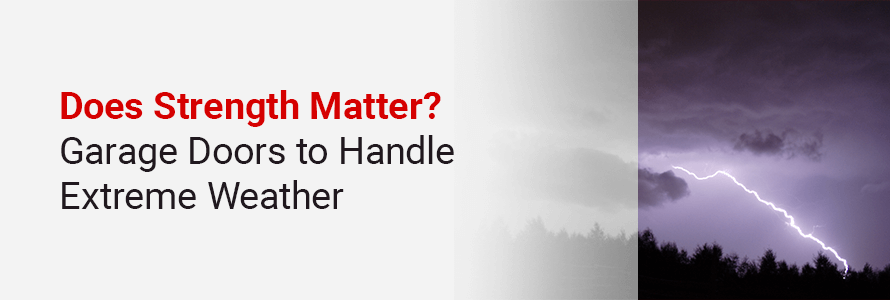
If you’ve lived in the eastern Washington or north Idaho area for some time, you know the region has four distinguishable seasons. The region’s changing, occasionally extreme weather conditions can impact your home’s structural integrity. A sturdy, well-constructed garage door is essential for minimizing the risk of extensive property damage.
How Does Extreme Weather Affect Your Garage Door?
Hot weather is not uncommon in the Inland Northwest — Spokane averages 21 days with temperatures of at least 90 degrees Fahrenheit each year. Bitter cold can also be an issue. In December, the city’s coldest month, the average overnight temperature is a chilly 21.6 degrees. While hurricanes and tornadoes don’t pose a threat in the region, high-pressure air forced against the Cascade Range to the west frequently produces heavy winds.
These factors can affect garage strength and impede the door’s performance. Intense heat and sunlight can interfere with the photo-eye, while melted snow and cold can cause the door to freeze shut. Heavy winds can also cause significant damage to the door’s hardware.
Best Garage Doors for Extreme Weather
Choosing the right garage door is crucial for minimizing the impacts of harsh weather. As a Clopay® Master Authorized Dealer® serving the greater Spokane area and north Idaho since 2001, Continental Door can install a reinforced door from Clopay®, the most trusted brand in North America.
The Clopay product line includes insulated doors that provide reliable protection against extreme temperatures. Although hurricane garage doors aren’t a necessity in the Pacific Northwest, Continental Door can also install a WindCode® compliant door from Clopay designed to withstand the force of heavy winds.
How to Prepare Your Garage Door for Extreme Weather
Use these steps to get your garage door ready for an extreme weather event:
- If strong winds are in the forecast, use any heavy objects you can find to brace the door.
- Insert steel pins into the locking mechanism to prevent the door from flying open unexpectedly.
- Use two-by-four pieces of wood to brace the locks further.
- If your garage has windows, cover them with plywood to prevent the glass from shattering.
- Replace worn or damaged weather stripping to keep air from heavy winds out of the garage space.
Request Garage Door Service From Continental Door
At Continental Door, we can repair garage door wind damage and meet all your other service needs. Contact us to request a free estimate or schedule a convenient service appointment today!
Your Guide to Operable Walls for Your Garage
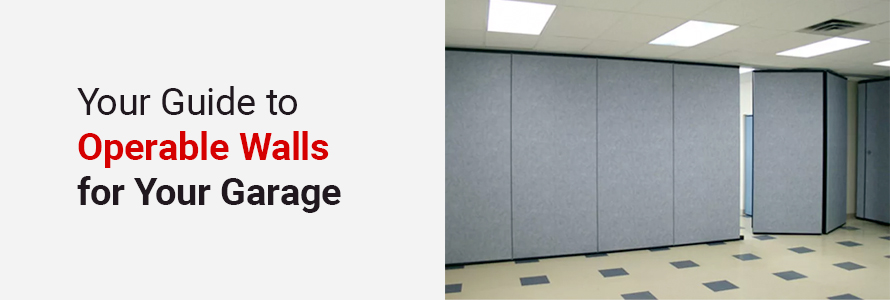
Have you ever looked at your garage and wondered how many amazing things you could do with all that extra space? Operable wall systems could be the ideal upgrade you’ve been looking for. You can build a temporary room in your garage using operable walls.
Operable walls are comprised of panels and act as the perfect room divider. Operable walls are unique among partition wall types. They’re practical, attractive and adaptable. Read on for everything you need to know about operable wall partitions.
What Is an Operable Wall?
An operable wall is a type of room divider preferred for easy assembly, sustainability and noise management. A system of individual panels makes up an operable wall. The panels can be used separately from one another but form an uninterrupted barrier when joined together. Operable walls are sturdy and provide permanent or temporary home additions.
Operable walls are easy to operate and maneuverable. There’s no need for a floor track, as the panels are often installed from the ceiling, but there’s the option for floor tracks if needed. Most operable wall systems have seals on the panels, so they provide an uninterrupted barrier once you’ve locked them into place.
How Can You Use an Operable Wall in Your Garage?
Operable walls allow you to make better use of the space in your garage. A garage partition wall can present many possibilities for using that extra space. You can build a temporary room in your garage and use it as an office, bedroom, recreational space or gym. The options are endless.
Installing operable wall partitions takes the permanence out of making an upgrade to your garage. Instead of calling in a crew of contractors and building a wall, you have a temporary option that will last as long as you need it. Operable wall systems give you extra room in your home, so let your imagination run wild.
What’s the Difference Between an Operable Wall and a Partition?
Both operable walls and partitions provide an opportunity to utilize your garage space better, but there are some differences between the two. Operable walls allow you greater flexibility in using your area, as you can keep an operable wall open or closed as you wish. Folding partitions are great if you’re looking for something less movable.
Types of Operable Walls

Operable walls come in several finishes, including metal, wood, veneer, glass and recycled materials. To find the best option for you, consider how much sound protection you’ll need for your garage, whether you’ll change the layout often or if want the light to pass through.
- Wood: For a more natural finish, operable wooden walls are a good choice. They add a rustic element to the overall aesthetics. When closed, they help with noise cancellation and provide room occupants privacy.
- Glass: Glass options allow natural light through and offer a crisp look with various opportunities to augment the glass and add finishes, including aluminum and wood.
- Metal: Consider metal options such as steel for added security, noise control and durability. Metal provides users with more permanence and can be decorated in many color combinations.
Things to Consider When Choosing an Operable Wall For Your Garage
You know you want to create a new room in your garage and have an idea of the different partition wall types available. Now, how do you choose? To get some more clarity, consider the following:
- Understand your budget: It helps to have an idea of what you’re willing to spend before you start. Some options will cost more than others, so you’ll want to clearly outline what you can afford.
- Think about how often you’ll want to move things around: If you plan on changing your space often, you should look at easy reconfiguring options. A once-off installation for a more specific purpose can be heavier and more permanent.
- Focus on sustainability: Operable wall systems are considered environmentally friendly, but if sustainability is especially important to you, consider those made from recycled materials.
- Consider the surface that fits best: Depending on what you plan to do with your space, certain surfaces of the room divider will work best.
- Remember the technology: You may need to run cabling through the wall system, depending on where the plug points are in your home.
- Consider privacy needs: How much privacy will you require in your space? Would opaque glass or recycled material do the trick? On the other hand, privacy might not be an issue at all.
- Achieve your aesthetic: When upgrading your garage space, you want it to look as goo as it functions. Choose the wall options that look best with your home’s design so your aesthetic flows throughout your house.
- Anticipate noise: The amount of glazing you choose depends on the amount of noise you want to avoid. Single-glazed doors are lighter, but they let more noise in. Double glazing gives you more options and cancels out some sound.
- Think about storage: When you want to remove your operable door system, consider how easy it’ll be to store the walls and where you’d keep them.
Benefits of Having an Operable Wall in Your Garage
Whatever you’d like to use the new room for, having a demountable partition wall system will improve your space. Aside from having a brand new room to use in whatever way you please, some of the other benefits of having an operable wall in your garage include the following:
- Practicality: There’s no need to make significant structural changes to enjoy a new space in your garage. Operable wall partitions are easy to move around. You can create a unique space in less time with less hassle and open it up as needed.
- Visual appeal: You can turn your garage into a space with spectacular interior design. No one will recognize your garage by the time you’re finished.
- Space management: Operable walls allow you to manage your space more effectively. Wasted space is a thing of the past, as you can partition the room and put every inch of your garage to good use.
- Cost-efficiency: You can add a new room to your garage without having to undergo construction, which can be costly.
- Adaptability: You can change things around as you need to with operable walls. If you don’t want to use the space as an office anymore, you might want to open it up for some indoor gardening, for example.
- Privacy: More than a simple room divider, operable garage walls can lower the noise level inside, making it perfect for a home office or other quiet area. You can also choose options that don’t allow anyone to look in while you’re busy.
How Do You Install an Operable Wall?
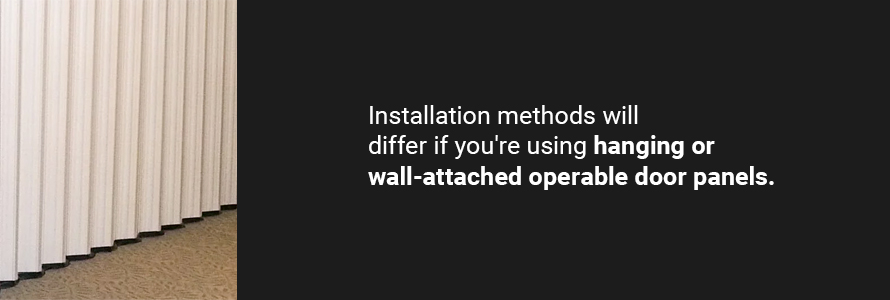
Installing an operable wall system is straightforward. The panels attach with simple attachment joints. Once you’ve lined the panels up correctly, the joints should clip into one another with ease. Then, you must connect the panels to something to complete the installation, which is most often the wall.
Installation methods will differ if you’re using hanging or wall-attached operable door panels. If you’d like to install hanging doors, you must drill the railing into the ceiling, then attach the doors. Should you be working on a wall-attached unit, take a look at these step-by-step instructions:
- Identify the wall mount side.
- Attach the top wall bracket.
- Install the bottom wall bracket.
- Lift the first panel into position.
- Attach the first panel to both wall brackets.
- Attach the rest of the panels, aside from the last one, to each other accordingly.
- Position the end panel perpendicularly.
- Attach the end panel.
- Open and close the wall.
How Do You Open and Close an Operable Wall?
Operable partitions are designed to open and close. Before opening or closing any panels, ensure the area is clear of any equipment that could damage the panels. When you’re not using your operable wall panels, you can store them in a stack or cupboard. Starting from there, move your panels into position using the following steps:
- Pull the first panel toward you.
- Move one panel at a time.
- Ensure all panels are straight.
- Set all the seals correctly.
- Reverse the process to close.
How Do You Uninstall an Operable Wall?
One of the best things about demountable partition wall systems is they can be temporary if needed. Uninstalling them is a simple process. Ensure you’ve removed all electrical cables and other hazards before you start. Follow these step-by-step instructions:
- Remove the trim.
- Score the seams if working with drywall.
- Unscrew the attachments.
- Remove the panels.
- Remove the wall mounts.
- Remove the anchor panel.
- Store the wall.
How Do You Maintain an Operable Wall?
Like any other structure, your operable wall system needs maintenance. Keeping it well-maintained gives it a longer life span, improves acoustic performance and keeps everything safe around the room. The best way to keep your wall system operating is to schedule professionals to perform routine maintenance on the system.
Some general guidelines for operable wall maintenance are as follows:
- Check the track system: Every six months, ensure the track system is level and the joints are aligned. Check for wear and tear, as you may need to replace them. Clean the inside flange of the track with a simple cleaner.
- Inspect the carriers: You may need to make adjustments every six months. Make sure the jamb or lock nut is still screwed in tight and the carriers are adjusted to the correct height.
- Go over the panels: Check your panels once a year for smoothness, working seals and damage to the trim or panel material. Clean all the rubber and vinyl parts with standard household cleaning products and some warm water.
- Clean all surfaces: At least every six months, clean all the surfaces and attachments and remove any dust or buildup. Use standard household cleaning products as needed.
If you’re uncertain about anything maintenance-related, consult a professional to ensure the longevity of your system.
Signs Your Operable Wall Needs Attention
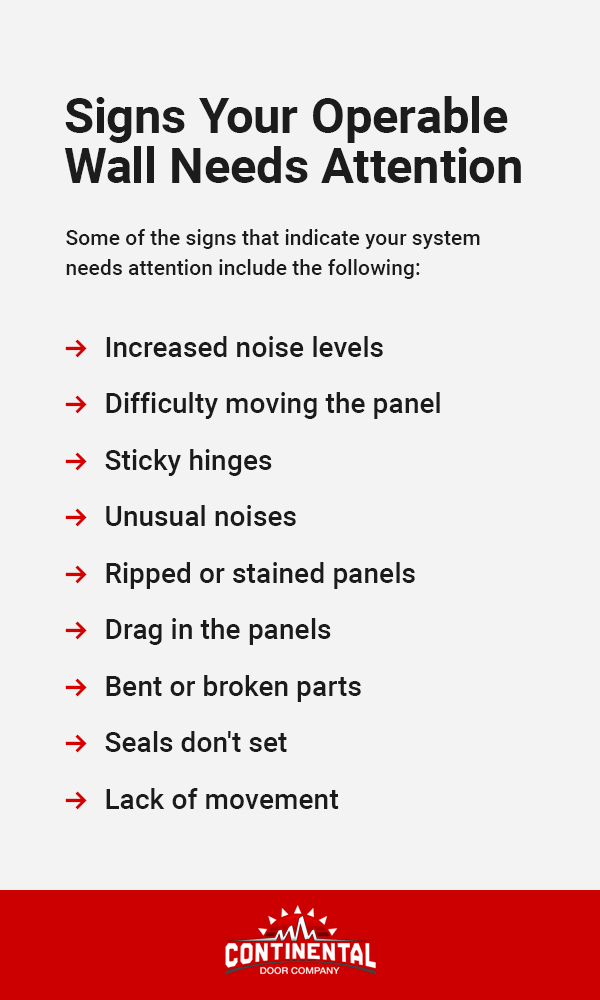
Taking immediate action as soon as you see signs of wear and tear on your operable wall system can increase its longevity and effectiveness. Some of the signs that indicate your system needs attention include the following:
- Increased noise levels: If you notice more noise is making its way through the seals, they may need replacing. Check that all the panels are straight and everything is in place. If everything looks good and noise is still coming through, call a professional to come and inspect your seals.
- Difficulty moving the panel: Panels should move effortlessly along the tracks. If things get sticky and the track is clear, you may need to replace some parts.
- Sticky hinges: If you need to shake things around to open a partition, the hinges may be bent or broken.
- Unusual noises: A strange scraping or grating noise when you move the panels along the track is a sign there could be a problem. Check the track for debris. If there isn’t any, your wall needs attention. Try not to move the panels until a professional has checked them.
- Ripped or stained panels: Dirty panels may still operate perfectly, but they do detract from the aesthetic and should be replaced.
- Drag in the panels: There could be something wrong with the ceiling track if the panels are dragging when you try and move them.
- Bent or broken parts: If parts are visibly damaged, they can cause issues in your whole system. It’s best to replace them as soon as possible.
- Seals don’t set: If they’re no longer set, they could require replacements. Check that the panels are straight and try the seal a couple of times. If they’re still not set, call a professional.
- Lack of movement: Address panels that aren’t moving along the track as soon as possible. There are several reasons this could be happening. Don’t force the panel along the track — have a professional check it instead.
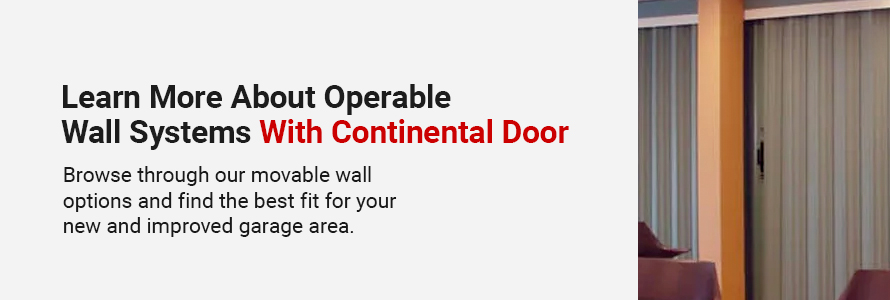
Learn More About Operable Wall Systems With Continental Door
If you’re in the greater Spokane area and interested in installing an operable wall in your garage, let Continental Door guide you through the process. You can trust our expertise — we’ve been at the forefront of commercial and residential garage door services for over 15 years and carry quality brands such as Clopay, Linear and LiftMaster, to name a few.
Browse through our movable wall options and find the best fit for your new and improved garage area. Feel free to contact us to learn more about what Continental Door can do for you.

